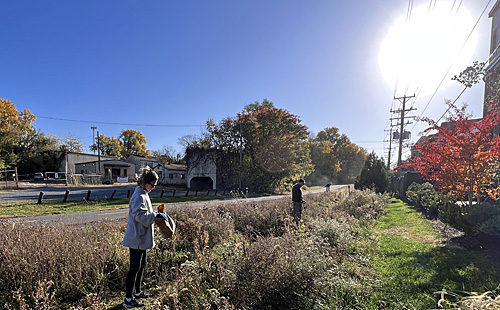Volume 28 Issue 1, Winter 2023
by Susan Abraham

A volunteer works among the faded last blooms and ripening seeds of asters in the Harrison Street meadow in Leesburg in late October. Photo by BJ Lecrone
Grasslands, meadows, prairies, and savannahs — these unique habitats have important differences in structure, life cycles, and complexity, yet each of them is dependent upon disturbance to persist in the environment. Fire, grazing, water inundation, and windthrow are some historic disturbances in our not-too-distant past that created conditions for these habitats to establish and thrive.
Today, agricultural and land development practices as well as fire suppression have profoundly altered the vast prairies once dominant in the Midwest, reducing them to remnants found on rocky, elevated soils, difficult to develop. Eastern meadows suffer similar challenges, as well as the constant pressure of succession to woodland habitats. Add the great threat of introduced weeds that outcompete our native vegetation for light, nutrients, and space and you have the perfect recipe for low-value landscapes.
The art and science of meadow making is young in our culture, thousands of years old for indigenous peoples, and millennial for Mother Nature. Careful observation of indigenous practices and knowledge of ecological principles can assist us in establishing a meadow. Making a meadow provides valuable habitat, essential ecological services, and breathtaking beauty.
Every meadow maker has an agenda. Early cultures capitalized on forest openings, creating rich ecotones (areas of transition between different habitats), to attract grazers and a diversity of edible and medicinal herbaceous plants not found in shaded woodlands. Employing fire and cuts, they managed a system of meadows in their forest farming practices. Contemporary meadow agendas may include pollinator habitats in a field adjacent to an organic farm or an outdoor classroom, support for grassland birds, or preparation of depleted soils for a future woody landscape.

A volunteer spreads seeds and mulch in the Harrison Street meadow in late October. Photo by BJ Lecrone
Once an agenda is understood, a mode of establishment can be determined. Clearing a meadow site by mechanical or chemical means requires a significant investment of money and time. A stripped area may foster quick seed sprouting rates, but it can also invite serious weed infestation. Although some projects may have the resources for this approach, it has been my experience that many do not.
If we consider what would be the least intervention necessary to begin the process of meadow making, we begin to manage our expectations in line with modest practices. Shepherding existing seed banks, suppressing introduced weeds through timed cuts, and planting native species into disturbed or bare areas over time is now my preferred approach to making a meadow. A meadow’s first year, its infancy, may require consistent care: some watering and weeding. During the second year, the toddler stage, it grows in fits and starts. The third-year adolescent meadow begins to shine, as plants find their niches, and by the fourth year its character is revealed. Every year, every season, every day, a meadow changes — a morning meadow looks quite different from a meadow at dusk. The way a summer breeze dances through the meadow is distinct from the flutter of birds alighting on native grasses poking through its winter coat.
The Harrison Street Meadow project in Leesburg (where a section of the W&OD trail bisects Harrison Street) is an example of this approach. A small pollinator meadow was established by enthusiastic area residents and Loudoun Wildlife members with support from the City of Leesburg, The Leesburg Garden Club, and NOVA Parks. Volunteers planted a variety of native plugs several years ago, weeding and mowing the site regularly. Sadly, when the Covid-19 pandemic interrupted volunteer activities, the meadow became overrun with introduced weeds.
The agenda at this juncture is to build upon initial efforts and develop a thriving pollinator habitat. Planting native grasses into existing bare spots will help provide competitive advantage over introduced weeds and give structure for flowering plants. Monthly cuts or mowing until mid-July heat arrives will also help keep weed seeds from developing, eventually allowing the native summer flowering plants to dominate as they become prevalent in the seed bank. Over time and with committed management, the Harrison Street Meadow will create a unique habitat for wild and human visitors.
Susan Abraham is a former professor in graduate studies at the George Washington University Sustainable Landscape Design program. She holds a master’s degree in sustainable landscape design, a BFA, and is a certified Watershed Steward and a Virginia Master Naturalist.

Volunteers work to remove weeds and plant seeds in the Harrison Street meadow in Leesburg in late October. Photo by BJ Lecrone

